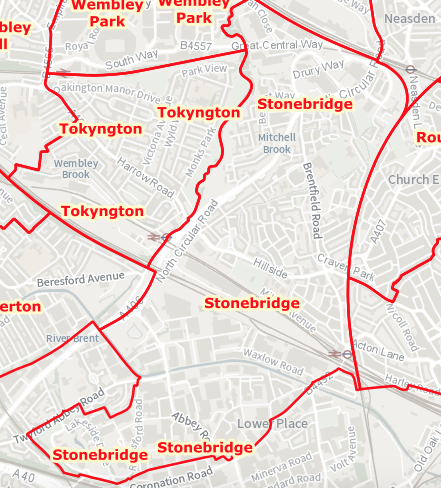With the Brent Council election coming up on May 5th public knowledge of the new wards and the reduced number of councillors in some wards is fairly low, so this is an attempt to summarise the information. If you are unclear on which ward you are now in you can search by postcode HERE
Proposed polling districts/stations can be found HERE
There are now 3 wards with Wembley in their names as Wembley Park (Quintain?) ward is now separated from Tokyngton, Muhammed Butt's ward and Wembley Hill has been added. There will be some jostling for nominations in the 2 member wards by existing councillors at next month's selections, although I understand a number have decided not to stand in in May. It is likely Labour will seek a male and female candidate in 2 member wards such as Cricklewood and Mapesbury and Barnhill where presently 2 of the 3 councillors are male.
The present arrangement is 63 councillors of whom 58 are Labour, 3 Conservative, 1 Liberal Democrat and 1 Liberal Democrat. There will be 57 councillors after the election.
The new wards have been drawn up based on population projections for 2024, maintaining existing communities as far as possible and having a fairly equal number of electors per councillor. Beneath each ward I have given the number of councillors, 2018 electorate/projected 2024 electorate/projected 2024 electors per councillor.
Alperton 3 councillors 9,692/13,187/4,396
Barnhill 2 councillors 7,703/8,868 /4,434
Brondesbury Park 2 councillors 9,131/9,256/4,628
Cricklewood and Mapesbury 2 councillors 9,133/9,407/4,704
Dollis Hill 3 councillors 13,745/13,831/4,610
Harlesden and Kensal Green 3 councillors 13,397/13,384/4,461
Kenton 3 councillors 13,165/13,815/4,605
Kilburn 3 councillors 11,986/12,581/4,194
Kingsbury 2 councillors 7,336/9,184/4,592
Northwick Park 2 councillors 9,322/9,330/4,655
Preston 2 councillors 7,969/8,147/4,073
Queens Park 3 councillors 12,343/12,797/4,266
Queensbury 3 councillors11,891/11,869/3,956
Roundwood 3 councillors 10,306/11,901/3,967
Stonebridge 3 councillors 12,383/13,338/4,446
Sudbury 2 councillors 8,858/8,725/4,363
Tokyngton 2 councillors 7,149/8,085/4,042
Welsh Harp 3 councillors 11,979/11,970/3,990
Wembley Central 3 councillors 12,040/13,138/4,379
Wembley Hill 3 councillors 9,715/11,735/3,912
Wembley Park 2 councillors 4,477/8,674/4,337
Willesden Green 3 councillors 12,411/12,509/4170






























